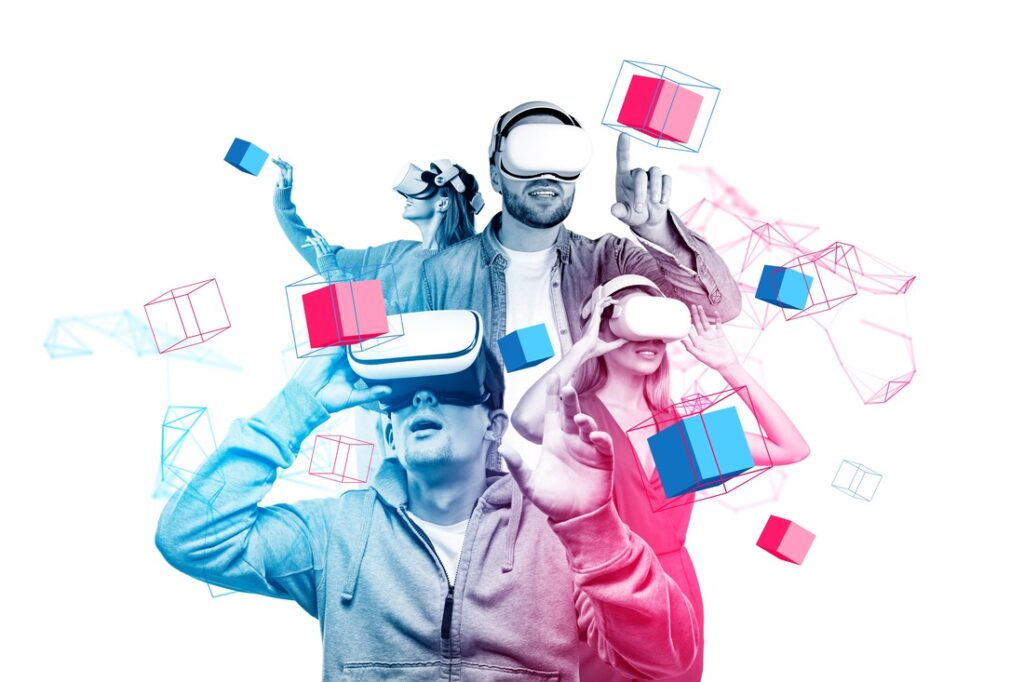The scene: You wake up at 6:30 a.m. You slip on your augmented-reality glasses with its stylish, minimalistic frames. You start to make your coffee when an alert pops up on the side of your coffee maker. The alert says you’re running out of espresso beans. “Would you like to add them to the grocery list?” it asks.
As you step outside and unlock the car, your glasses issue a reminder. The reminder says your car needs an oil change. The glasses offer to schedule the appointment for you. You have an opening on Thursday after lunch. You make the appointment. Then, you get in the car and drive to work.
These experiences are an intentionally banal depiction of how augmented reality (AR), virtual reality (VR) and mixed reality will impact life as we know it. And how artificial intelligence (AI) will shape our lives as extended reality (XR) experiences become more widely used.
Although the narrative sounds like something out of science fiction, it’s close to becoming a reality, according to researchers Alvin Graylin and Louis Rosenberg. Their book Our Next Reality: How the AI-Powered Metaverse Will Reshape the World is structured as a debate around the techno-utopian and dystopian potentials of XR technology and the role AI plays as these experiences continue to be developed and perfected.
What is the metaverse and when will we get there?
For Graylin and Rosenberg, it’s not a matter of when we will be able to use the metaverse. It’s the cultural, financial and ethical implications of technologies that will almost certainly be in widespread use within the next decade.
If you’re a science-fiction fan, you’ve likely read Neal Stephenson’s novel Snow Crash. In the novel, users of the metaverse don virtual-reality goggles to experience a virtual world. They explore the metaverse as avatars—digital representations of themselves they can customize to appear however they like.
Stephenson’s satirical future was a novel idea 32 years ago when his book was published. But as companies continue to design VR and AR experiences for work and play, it’s apparent the metaverse is more than futuristic chatter among tech bros—it’s reality. Augmented reality is used to bring museum exhibitions to life, enhance online shopping experiences and even help physicians in real-time as they perform surgical procedures.
In Stephenson’s visualization of the metaverse, a subculture of individuals exist who remain connected to the metaverse. They wear portable devices all day. These individuals are nicknamed “gargoyles” because of their appearance while wearing these devices.
If that sounds far-fetched, just consider Microsoft’s HoloLens 2 or Apple’s Vision Pro headset.
While the Vision Pro is clunky and futuristic, there are other stylish and normal-looking forms of smart eyewear, like the Ray-Ban Meta glasses. Tech startup XPANCEO has even prototyped a set of smart contacts they plan to test in 2026.

AI: Augmenting everyday life
Virtual world-building at scale is a big endeavor. Augmenting all our daily experiences is just too big a task for human designers. This is where AI comes into the picture.
Generative AI—the kind that can produce content—has the ability to create more of it on a larger scale faster than humans.
“The real world is big. And if you really want to augment it with content, [it] is everywhere you go and everything you experience. AI-generated content is going to be significant,” Rosenberg says. “You could now create content at scale that is customized for individuals and customized for the locations… they’re in.”
“I think one of the issues [that has] kept XR or VR from really taking off in the last 10 years… is because of insufficient content,” Graylin notes. “There hasn’t been enough content [for people to] go in there and use it every day.” With generative AI, there might soon be an unlimited supply.
Augmented marketing
One of my Facebook friends recently made a post about her job, saying, “I will find a way to inject unskippable ads directly into the human experience.” We are not too far away from this reality. As people spend more time in XR, it will be a prime environment for advertisers to place their products directly into our consciousness.
“Meta had a demo of this in their glasses just a couple of months ago. You can walk into a clothing store and pick up a pair of shoes,” Rosenberg explains. “The AI sees that pair of [shoes]. I can now recommend a shirt that goes with it…. It’s amazing technology, but it’s also kind of a creepy technology and one that I think we should worry about a lot. We’re going to allow AI powered by a corporation to be basically whispering in our ears all day long and seeing what we can do, hearing what we hear and potentially influencing what the world looks like around us. That’s a lot of power to give to anybody.”
AI and advertising
Instead, advertising could be replaced with an AI agent—a virtual assistant doing product research and shopping for us. Although people might object to giving up their privacy in all cases, there are some instances where the benefit of personalization outweighs the cost of our privacy.
“I think that the future is coming where people will proactively say, ‘I don’t want privacy from this AI, but I want it from every other AI,’” Graylin says. “’This AI is my eyes. It’s my agent that will then go and shop for me [or] attend meetings for me.’”
When social media was first introduced, consumers’ unwillingness to pay for it opened the current advertising model of data collection. As the metaverse continues to evolve, our contracts as consumers might need to change to prevent advertisers from digging deeper into our interactions and behavior.
“If the AI tools that we’re using are driven by business models that are all about collecting data and selling influence, they will be so much more targeted and so much more powerful than even social media has been in that regard,” Rosenberg notes. “It’s up to consumers to demand privacy.”
Augmenting the future
Our digital echo chambers are abuzz about the potential impact of AI on the way we work and whether we will have jobs at all in the future—and for good reason.
In the past couple of years, we have become bombarded with evidence that AI can create text and images that are convincingly human. As technology improves, so does its capability to take on our work responsibilities.
At the end of Our Next Reality: How the AI-Powered Metaverse Will Reshape the World, there is a section that offers tips for policymakers, leaders both in and outside of tech, children, students and law enforcement. Leaders, in particular, need to consider the benefits and drawbacks of technology in their industries. And the long-term decisions for improving efficiency.
AI, productivity and beyond
“Get your staff trained up on the technology,” Graylin says. “But I think the other thing is really understanding that [just] because your productivity increases, it’s probably not necessarily the best thing [to] immediately cut your staff. Everybody does that. It creates a very large disruption to the job market, which can tend to have the kind of negative ramifications that waterfalls on itself.”
Rosenberg adds, “My first recommendation to anyone who’s at all afraid of AI is [that] you could be afraid of it, you could think it’s not necessarily going to work out well, but you should still be using the technology so that you’re aware and you can make good decisions.”
So, should we worry about whether technology will take our jobs? Or should we reimagine how we think about work altogether? Technology will continue to progress. And as our way of work becomes increasingly impacted by machines, labor itself might take on its own meaning.
“I mean, the whole point of technology is that [it] has made us increasingly more productive by 1,000 times over,” Graylin adds. “And if that’s the case, we should be able to work less in terms of being forced to work. And [instead be] doing the things we enjoy and make us more fulfilled.”
This article original appeared in the July 2024 issue of Success+ Magazine. Photo courtesy of Image Flow/Shutterstock










